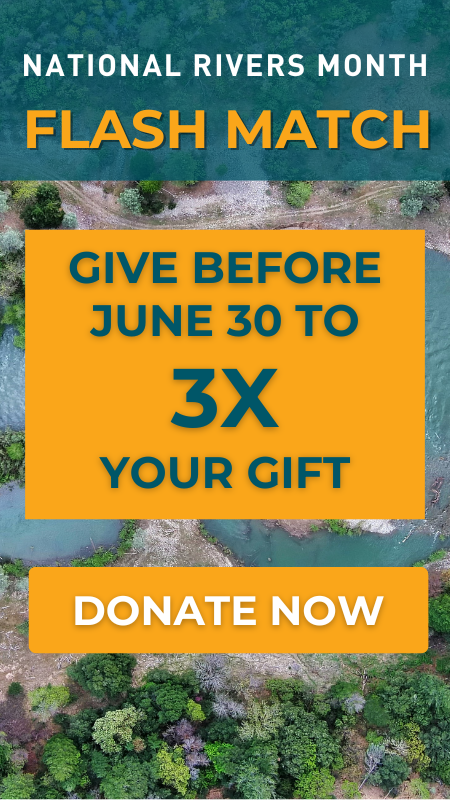Disappearing Rio Grande Expedition
October 24, 2014
Contact:
(Washington, DC) – American Rivers President Bob Irvin will join the “Disappearing Rio Grande” Expedition in Big Bend National Park on Monday to draw attention to the importance of the river and the impact climate change is having on rivers and water resources across the West.
The Disappearing Rio Grande Expedition is highlighting how drought and water overuse are affecting the river. The trip retraces the 1977 National Geographic and Dartmouth College-sponsored expedition that was the first to navigate the entire 1,888-mile Rio Grande. The current expedition began in July, with reporter Colin McDonald and photographer Erich Schlegel blogging daily via satellite for The Texas Tribune.
American Rivers named the Rio Grande (called the Rio Bravo in Mexico) among America’s Most Endangered Rivers® in 1993, 1994, 2000, and 2003 because of overuse and outdated water management. Last year, the Bureau of Reclamation released a report looking at the impact of climate change on the upper Rio Grande. The report found that the basin will likely see decreased snowpack and more frequent and intense floods and droughts.
American Rivers called on water managers to embrace increased water efficiency, conservation, and reuse as the fastest and most reliable, flexible, and cost-effective water supply solutions on the Rio Grande and on other rivers facing the impacts of climate change.
“The Rio Grande is woven into our nation’s history and heritage. It is a lifeline of the Southwest, irrigating crops, quenching the thirst of communities, and supporting imperiled fish and wildlife. The river is also a prime example of the consequences we face when outdated water management collides with climate change,” said Bob Irvin, President of American Rivers. “We must embrace new water supply solutions on the Rio Grande. Not only do water conservation, efficiency, and reuse make economic sense, these solutions will ensure we leave a healthier river for future generations.”
“We kayaked the length of the Rio Grande in a very different time, when water was more plentiful, and cities and farmers less thirsty,” said Dan Reicher, a member of the 1977 National Geographic and Dartmouth College-sponsored expedition and a member of the American Rivers Board of Directors. Bob Irvin will join Reicher and Fred St Goar, fellow American Rivers Board Member and Dartmouth graduate on the Wild and Scenic portion of the river, through Big Bend National Park. “This trip is shining the spotlight on a river that simply isn’t receiving the attention it deserves. We hope to capture national attention, spur dialogue, and inspire solutions for the river and its communities,” Reicher said.
U.S. Senator Rob Portman (R-OH), also a member of the 1977 expedition, will join the current expedition via Skype in the Big Bend canyons for a conversation with trip members. Senator Portman has a kayak from the original six-month expedition hanging on the wall of his Senate office.
From its headwaters in the mountains of southern Colorado, the Rio Grande flows through 1,888 miles of the arid Southwest and much of America’s national mythology. On its way to the Gulf of Mexico at Brownsville, Texas, the Rio Grande drains eleven percent of the continental United States. Despite its name – Spanish for “Great River” – the Rio Grande averages only about one-fifth the flow of its neighbor, the Colorado River, and experiences more frequent droughts. Will Rogers once called the Rio Grande “the only river I know that is in need of irrigation.” Often the entire flow of the Rio Grande is diverted for municipal and agricultural use, leaving parts of the river completely dry. In many years, the river fails to reach its mouth at the Gulf of Mexico.
To learn more or follow the “Disappearing Rio Grande” Expedition visit: riogrande.texastribune.org or the Facebook page.
About American Rivers
American Rivers protects wild rivers, restores damaged rivers, and conserves clean water for people and nature. Since 1973, American Rivers has protected and restored more than 150,000 miles of rivers through advocacy efforts, on-the-ground projects, and an annual America’s Most Endangered Rivers® campaign. Headquartered in Washington, DC, American Rivers has offices across the country and more than 250,000 members, supporters, and volunteers.
Rivers connect us to each other, nature, and future generations. Find your connections at AmericanRivers.org, Facebook.com/AmericanRivers, and Twitter.com/AmericanRivers.


